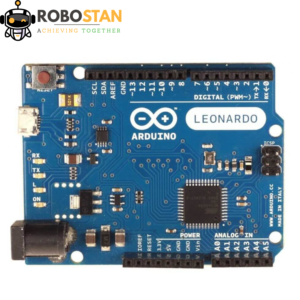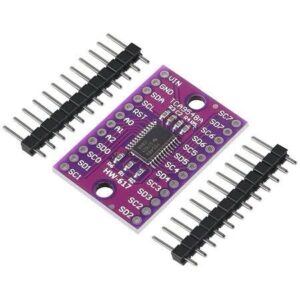Buy USB Digispark ATtiny85 Developing Board In Pakistan Key Features:
Buy USB Digispark ATtiny85 Developing Board In Pakistan. The ATtiny85 is an 8-bit microcontroller that features a range of essential components in a very compact package. Below are some of the key features of the ATtiny85 module:
- Processor Core: The ATtiny85 features a 8-bit AVR microcontroller core. The processor runs at a clock speed of up to 20 MHz, providing sufficient processing power for many simple embedded applications. While not as powerful as higher-end microcontrollers like the ATmega series or ARM Cortex chips, the ATtiny85 is more than adequate for tasks such as reading sensors, controlling actuators, driving LEDs, and handling simple communications.
- Flash Memory: The ATtiny85 comes with 8 KB of flash memory, which is used for storing the program code. This amount of memory is suitable for many simple embedded projects, though larger and more complex applications may require external storage or optimization of code size.
- RAM and EEPROM: It has 512 bytes of SRAM (Static Random Access Memory) and 512 bytes of EEPROM (Electrically Erasable Programmable Read-Only Memory), which are used for storing runtime data and non-volatile settings. EEPROM is particularly useful for saving values that need to persist across power cycles, such as configuration settings or sensor calibrations.
- Input/Output Pins: The ATtiny85 has a total of 8 I/O pins, which can be configured as digital inputs or outputs. Some of these pins are also capable of alternate functions such as PWM (Pulse Width Modulation), analog input (ADC), and SPI communication. The ability to configure these pins for a variety of functions makes the ATtiny85 highly adaptable for different project requirements.
- Analog-to-Digital Converter (ADC): The ATtiny85 includes a 10-bit ADC, which allows it to convert analog signals (e.g., from sensors like thermistors, light-dependent resistors, or potentiometers) into digital values that the microcontroller can process. The ADC has up to 4 input channels, giving it the flexibility to read multiple sensors at once.
- Low Power Consumption: One of the ATtiny85’s standout features is its low power consumption. With various sleep modes available, the ATtiny85 can be powered using small batteries, making it ideal for battery-operated applications such as portable sensors, wearable electronics, and remote devices. The module is typically designed to run efficiently at low voltages, often down to 2.7V.
- Programming and Debugging: The ATtiny85 module is typically programmed via ISP (In-System Programming) using tools like USBasp or Arduino as ISP. It is also compatible with the Arduino IDE, thanks to the ATtiny85 core that can be added to the Arduino environment. This makes programming the ATtiny85 accessible to a broad audience of hobbyists and engineers who are already familiar with the Arduino ecosystem.
- Size and Form Factor: The ATtiny85 chip itself is very small (5mm x 5mm in its package form), and the module is usually mounted on a tiny PCB with additional components such as capacitors and resistors, which provide necessary decoupling and ensure stable operation. The module is typically small enough to fit in space-constrained applications, such as wearable devices, small robotics, or other embedded systems where saving space is critical.
Buy USB Digispark ATtiny85 Developing Board In Pakistan Applications :
Buy USB Digispark ATtiny85 Developing Board In Pakistan. Given its small size, low power consumption, and flexibility, the ATtiny85 module is used in a wide variety of applications. Here are a few examples of where this tiny microcontroller can be put to use:
- Wearable Electronics: The ATtiny85 is ideal for wearable electronics due to its small size and low power draw. It can be used in projects like fitness trackers, heart rate monitors, or smart clothing, where space and battery life are essential.
- Sensor Monitoring: The ATtiny85 is commonly used for data logging and sensor monitoring in compact systems. With its analog-to-digital converter, it can read sensors like temperature, light, humidity, or accelerometers, and transmit the data to a larger system or store it for later use.
- LED Control and RGB Projects: Its ability to drive PWM signals makes the ATtiny85 a great candidate for controlling LEDs, particularly in projects that involve color-changing LEDs (RGB strips) or custom lighting setups. It’s commonly used for small LED displays, decorative lights, or indicator lamps.
- IoT Projects: The ATtiny85 is often used in Internet of Things (IoT) applications, especially in cases where wireless communication is not required or is handled by another module (e.g., Bluetooth, Wi-Fi, or Zigbee). It can act as a local controller, reading sensors and transmitting data or controlling actuators in IoT systems.
- Embedded Robotics: For small, low-cost robots or robotic systems, the ATtiny85 offers a simple, compact, and cost-effective solution for controlling motors, sensors, and other peripheral devices. Its small form factor makes it suitable for applications where space is at a premium.
- DIY Projects: Thanks to its compatibility with the Arduino IDE, hobbyists and makers use the ATtiny85 module for countless DIY projects, ranging from simple gadgets to complex interactive systems. Its affordability and ease of use make it a great choice for prototyping and experimentation.
Conclusion
The ATtiny85 module offers an excellent balance of size, power, and functionality, making it a go-to choice for developers working on small, embedded systems. Whether used for sensor monitoring, LED control, or DIY electronics, this microcontroller delivers enough performance and flexibility to handle a wide variety of tasks. With its low power consumption and small footprint, it is particularly suited for battery-powered and space-constrained applications. Combined with the ease of programming through the Arduino IDE and the availability of various development tools, the ATtiny85 continues to be a popular and powerful microcontroller for both beginners and advanced users alike.





